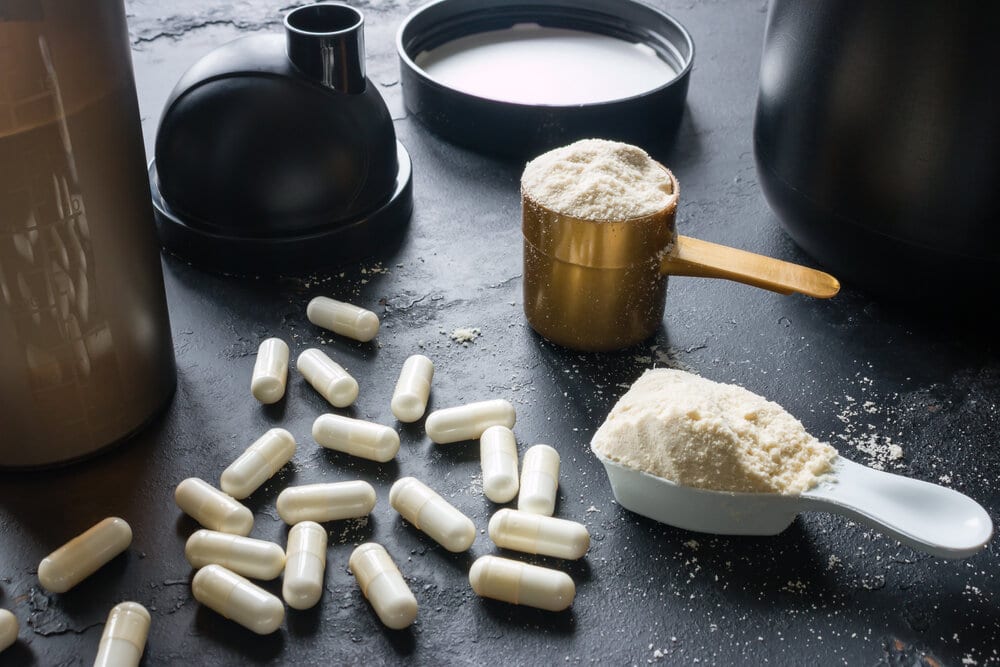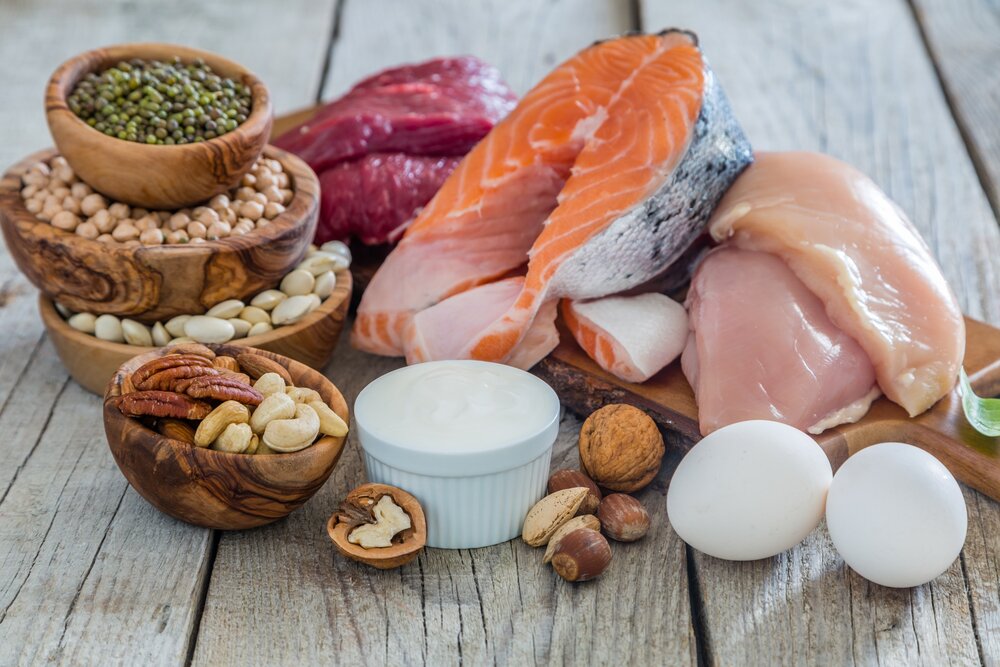Amino acids are basically the building blocks of protein, and if you care about muscle growth and recovery, they’re kind of a big deal.
When it comes to supplements, there are two main types that athletes and gym-goers swear by: branched-chain amino acids (BCAAs) and essential amino acids (EAAs). But what’s the difference, and do you really need them?
Which one is better to maximise your gains? In the following piece I explore their unique benefits and provide advice regarding optimal timing/dosage through supplementation or dietary considerations if you plan on meeting your needs through food.
With a greater understanding of the differences between BCAAs and EAAs, you can finally make an educated decision about which is going to be the better option for you.
Key Takeaways
- BCAAs and EAAs are important for muscle growth, repair, energy maintenance, and immune system support.
- BCAAs provide accelerated recovery and reduced soreness, while EAAs offer a more comprehensive approach to optimising muscle growth.
- Timing of supplementation is key. Protein-rich foods or additional planning/supplementation may be necessary for those on plant-based diets.
Understanding Amino Acids: The Building Blocks of Proteins
Amino acids are important for the growth, maintenance, and repair of muscles, as well as protein synthesis. Hence why they have become a favored component in dietary supplements among athletes and advanced lifters.
Out of all amino acids available, there are twenty types which can be divided into three main groups: essential, non-essential, and conditionally essential. EAAs encompass those nine molecules that cannot be generated within the body and must come from foods or other sources.
One such category is branched-chain amino acids (BCAAs), consisting of leucine, isoleucine, and valine—so named due to their unique chemical structure separating them from regular EAA compounds.
Essential Amino Acids (EAAs)
Essential amino acids are important for many functions in the body, such as muscle development and energy production.
These cannot be naturally produced by the organism so they need to come from dietary or supplemental sources.
There are nine of them: histidine, leucine, methionine, threonine, valine, isoleucine, lysine, phenylalanine, and tryptophan.
Essential amino also bring many advantages when consumed regularly, like aiding muscular growth and improving mood. Thus EAAs occupy an important place regarding health maintenance.
Non-Essential Amino Acids (NEAAs)
Non-essential amino acids are still essential to the body’s health, though they do not have to be obtained through food.
Some different NEAAs include alanine, arginine, asparagine, aspartic acid, cysteine, glutamic acid, glutamine, glycine, proline, serine, and tyrosine. Some of these amino acids play a role in immune function and energy production.
Conditionally Essential Amino Acids
In certain situations, such as times of hardship or disease, a diet may need to provide conditionally essential amino acids. The body might not be able to make enough conditional aminos for its needs so supplementation is necessary.
This accentuates the importance of considering individual conditions when designing a diet plan and supplemental regime. Essential and conditionally essential types of amino acids are vital in this context.
Conditionally essential amino acids include arginine, cysteine, glutamine, tyrosine, glycine, proline, and serine.
Branched-Chain Amino Acids (BCAAs): Focused on Muscle Growth and Recovery

BCAAs are a type of essential amino acid specifically used to promote muscle growth and recovery. Leucine is the most important when it comes to protein synthesis, making its usage key in growing muscles effectively. Isoleucine and valine also assist with energy maintenance and immune health.
Although BCAAs provide an edge over some EAAs with regards to speedy relief from post workout soreness, they only make up three out of nine total EAAs that are important for complete nutritional support.
Leucine’s Role in Muscle Protein Synthesis
Leucine, a key BCAA that is necessary for muscle protein synthesis and growth, should be consumed in order to ensure maximal results. The current recommended dietary intake of leucine is 45 mg/kg bodyweight/day for sedentary individuals.
Thus, those participating in high-intensity training should aim to consume more. This essential component works hard within our bodies promoting development, repairs, and injury healing.
It’s obvious why those looking for fitness gains need to make sure they have ample amounts either through their daily diet or by taking supplements.
Isoleucine and Valine: Supporting Players
BCAAs, such as isoleucine and valine, are important components of muscle growth and health. They not only help build new proteins, they also support immune function by taking part in key pathways that control protein synthesis, such as the mTORC1 signalling pathway.
Together, these two amino acids contribute to an individual’s overall health and performance levels. Leucine still holds a fundamental role for muscle protein synthesis, but when combined with isoleucine and valine, this process can be optimized even further!
Essential Amino Acids (EAAs): Comprehensive Benefits

EAAs offer many advantages when it comes to muscle growth, repair, and health. They are essential in regards to:
- Protein synthesis which helps with the formation of muscles;
- Alleviating muscle aches and exhaustion after physical activity;
- Taking part in multiple metabolic processes that contribute to an overall healthy state.
BCAAs primarily concentrate on aiding protein synthesis and developing lean mass, while EAAs provide a more extensive solution for those striving to achieve peak performance.
These benefits include soreness reduction and enhanced injury recovery and healing, making EAAs one of the most versatile supplement formulations available.
EAAs and Muscle Protein Synthesis
EAAs are the key building blocks for proteins in muscle tissue and thus play a fundamental role in protein synthesis.
This is essential to promote the growth of muscles, as well as repair any damage, helping maintain lean mass that largely contributes to overall health and performance.
EAAs help preserve existing muscles by facilitating the proper production of new proteins necessary for muscular repair. During a workout, EAAs may slow or prevent excess muscle damage by upregulating protein synthesis pathways.
Additional Health Benefits of EAAs
EAAs play an important role in muscle growth and repair, but they offer so much more than that. They can help to improve the immune system’s performance, increase energy levels and cognitive function, and reduce inflammation.
Getting adequate amounts of EAAs may even contribute to better sleep quality and reduced stress levels—making them a great choice for anyone looking after their overall wellbeing.
BCAAs vs. EAAs: Which is Better for Your Gains?

When trying to decide between BCAAs and EAAs for muscle growth and recovery, the key is understanding their individual benefits. Taking BCAA supplements can reduce post-workout soreness and accelerate overall healing time.
While BCAAs are important components of the overall amino acid profile, the nine EEAs offer an entire suite of vital benefits that enable greater all-around health and wellness support.
Ultimately it comes down to what you hope to gain from supplementation since both options have different advantages.
Those seeking immediate relief from discomfort might benefit from using only BCAA supplements, while those looking for more comprehensive health benefits could see improvement with EAA supplements alongside a complete, balanced diet.
BCAAs: Faster Recovery and Reduced Soreness
BCAAs are useful when it comes to decreasing muscle pain and accelerating the recovery process after strenuous exercise. This is because they can activate protein synthesis in muscles, as well as stop muscular deterioration.
Subsequently, BCAAs can help you bounce back more quickly from a workout, while also reducing post-workout soreness so that your training routines stay consistent and progress efficiently.
It’s noteworthy that solely consuming BCAAs will not have an extensive influence on protein synthesis reactions. To gain optimal benefits for growing muscles, one must consume all of the amino acids contained in either complete proteins or EAA supplements combined with a balanced diet.
EAAs: Optimal Muscle Growth and Comprehensive Support
The nine essential amino acids present in a balanced dietary intake offer an all-inclusive solution to muscle growth and repair and general well-being.
To aid in protein synthesis, studies suggest that consumption of EAAs may enhance immune system performance, energy levels, and cognitive functionality.
Taking them following exercise can improve recovery rate by decreasing post-exercise soreness while still promoting additional increases in muscle size and function.
To optimize gains from fitness activity or maintain health through regular dieting, incorporating adequate amounts of EAAs into your plans is key.
Supplementation Strategies: Timing and Dosage

For optimal results, it is essential to adhere to proper dosage and timing when supplementing with BCAAs and EAAs. Depending on personal needs or objectives, BCAA supplementation can be used prior to, during, or after physical activity.
Doing so will facilitate muscle repair and diminish the soreness usually associated with strenuous exercise. EAA intake should occur before training sessions to best support protein synthesis of the muscles.
The recommended dose of BCAAs is 5-10 grams 1-3 times daily, while the recommended dose of EAAs is 10-20 grams 1-3 times daily. To ensure safety while supplementing, we advise one to consult with their healthcare professional prior to adding a new supplement to their regimen.
When to Take BCAAs

For the best outcome, BCAAs should be taken prior to or after exercise in order to help repair muscle damage and ease soreness. Consuming the supplement 15 minutes before physical activity will also provide muscles with energy and boost performance.
Reaching their peak level 30 minutes following ingestion, BCAA consumption post-exercise is advantageous as well.
When to Take EAAs
Incorporating EAAs into your diet can help optimize muscle development and recovery. Consuming them prior, during, or after exercise has been known to lessen post-workout soreness and promote protein synthesis in the muscles.
Ingesting these supplements between meals may also result in greater gains regarding muscular growth and overall functionality.
Diet Considerations: Meeting Amino Acid Needs Through Food
A balanced diet that is rich in protein can be an effective way to get your BCAAs and EAAs. Examples of high-protein foods include meat, fish, dairy, and whey products.
For those on plant-based diets, it may require extra effort or supplementation to ensure sufficient intake of amino acids. It is vital to adhere to a well-planned, healthy diet to meet your body’s requirements for amino acids.
Combining nutrition from food with the use of an amino acid supplement could help you reach optimal muscle growth and overall health and wellness.
Protein-Rich Foods
Consuming a variety of protein-rich sources is necessary for optimal fitness goals. These items include meat, fish, dairy, and whey products which provide enough amino acids.
For those following plant-based diets, there are also complete proteins with all nine essential amino such as quinoa, buckwheat, hemp seed, or soybeans.
Legumes, like peas and beans, contain high levels of lysine to support muscle growth and repair. By consuming these various foods, it’s possible to get the right amount of required amino acid intake..
Plant-Based Diets and Amino Acid Intake
If you’re on a plant-based diet, it’s important to make sure that your amino acid requirements are met. This can be done through mindful eating or supplementing with certain proteins.
Due to the metabolic inequality between animal and plant-based proteins, carefully selecting sources and potentially combining whole foods with supplementation will provide good muscle growth while sustaining optimal, overall health.
Summary
Both BCAAs and EAAs are essential for building muscle mass, restoring tissue damage, and preserving general health. Athletes tend to turn towards BCAA supplements, which primarily contain leucine, valine, and isoleucine, to focus on restoration after intense physical activity.
Meanwhile, those wishing to gain a more comprehensive well-being opt into supplementing with EAAs that provide a complete solution for both muscle growth and recovery plus overall health benefits.
Frequently Asked Questions
Should I buy EAAs or BCAAs?
BCAAs are an excellent source of energy to get you through a workout, but if muscle growth is your goal, then EAA supplements should be the top priority. These provide better long-term advantages and will help you attain the desired result. So go for it!
Are EAAs and BCAAs the same?
The three BCAAs are leucine, isoleucine, and valine. These specific compounds have an exclusive molecular structure with a branched pattern. BCAAs are also considered to be essential amino acids.
There are nine EAAs that cannot be produced by the and must be consumed through diet. In other words, all three BCAAs are EAAs, but not all EAAs are BCAAs.
While BCAAs and EAAs may be different in some ways—such as their shape or source—they should not be overlooked as they are crucial components for gaining healthy body strength.
Can I take EAAs and BCAAs together?
EAAs and BCAAs can be taken together to provide maximum benefits. Research has found that EAA supplementation can help preserve lean body mass while also providing an optimal environment for muscle gains.
By taking both kinds of supplementations, you could experience great results with regard to your fitness goals.
What is the difference between BCAAs and EAAs?
Amino acids are beneficial for muscle growth, repair, and health. The focus of BCAAs is primarily on muscular development and recovery, whereas the range of benefits offered by EAAs extends to encompass overall strength and well-being.
How can I ensure adequate amino acid intake through my diet?
Achieving optimal health and performance means making sure that your diet contains an adequate amount of amino acids.
Ensure that you get a balanced combination of protein-rich foods such as meat, fish, and dairy products or even plant proteins. Having this diverse selection is key to providing essential nutrients for our bodies.






